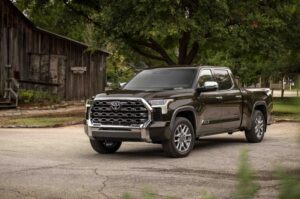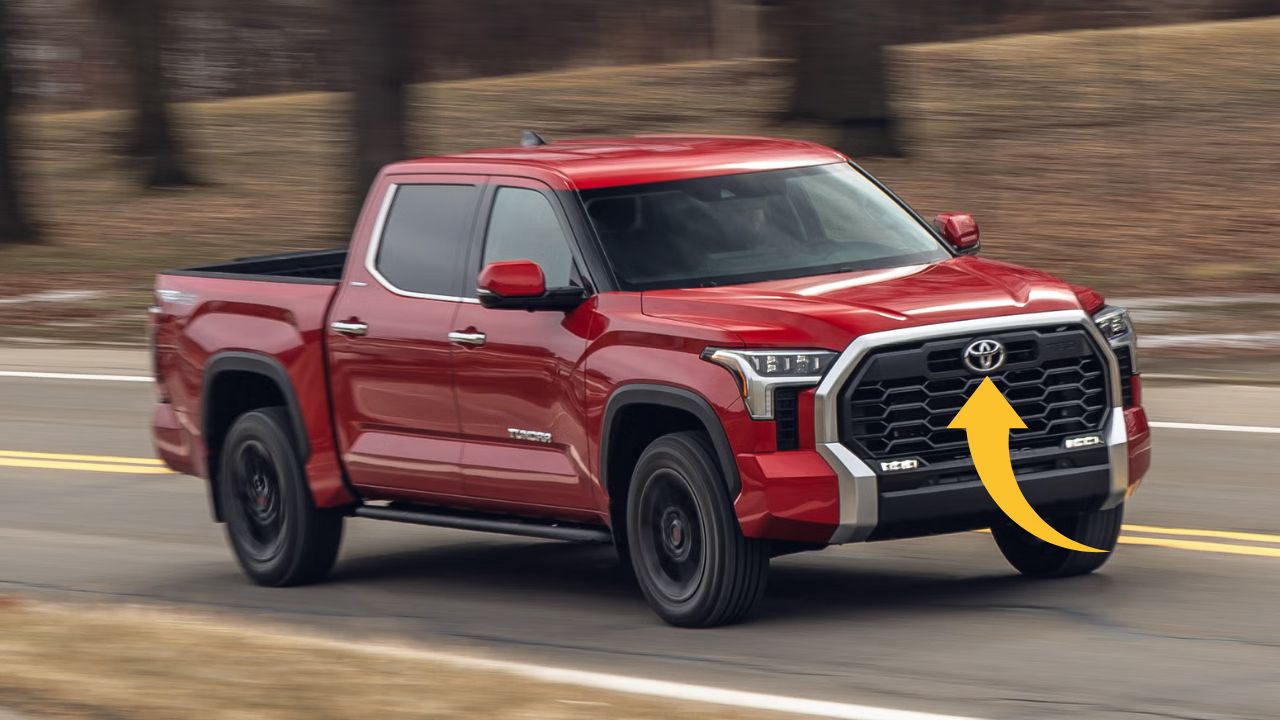The Toyota Tundra, a full-size pickup truck celebrated for its rugged capability and bold presence, has faced a significant setback in Australia with a safety recall affecting all 1,532 Tundras sold locally between June 30, 2021, and March 7, 2025. Announced on May 16, 2025, by Toyota Australia, this recall addresses a critical defect in the reverse light assemblies, where moisture intrusion can cause corrosion, leading to potential lamp failure or unintended activation. This issue, impacting 2022–2025 model year Tundras and Tundra Hybrids, compromises rear visibility and increases collision risks, sparking concern among Aussie owners, from urban tradies to outback adventurers. This article delves into the recall’s details, its implications for Australian drivers, the Tundra’s specs and appeal, and Toyota’s response, while comparing the situation to other market challenges. #ToyotaTundraRecall #AustralianCars #VehicleSafety
The Recall: A Critical Reverse Light Defect
The 2025 Toyota Tundra recall centers on a manufacturing flaw in the reverse light assemblies. According to Toyota Australia, the multi-layer vent patch in these assemblies, designed to equalize pressure while preventing water intrusion, may separate due to thermal cycling. This compromises the adhesive, allowing moisture to enter and corrode the internal circuit board, connectors, or wire harness. As a result, the reverse lights may fail to illuminate when reversing, reducing visibility in low-light conditions, or activate unexpectedly, confusing other road users. In worst-case scenarios, this could disable the reversing camera’s effectiveness at night, as it relies on the lights for illumination, increasing the risk of collisions with pedestrians or vehicles.
The recall affects all Tundras sold in Australia, a smaller market compared to the U.S., where 443,444 vehicles are impacted (2022–2025 models). In Australia, the Tundra’s limited sales—1,532 units—reflect its niche status as a full-size pickup competing with the Ford F-150 and Ram 1500. Toyota dealers will replace both reverse light assemblies with improved versions free of charge, with repairs taking approximately two hours, though scheduling may extend this timeframe. Owners will receive notifications by mid-July 2025, and can check their vehicle’s status using the Vehicle Identification Number (VIN) on www.toyota.com.au/recall or www.vehiclerecalls.gov.au. The recall codes are 24TB06 and 24TA06, and Toyota’s helpline (1800 987 366) is available for inquiries. #SafetyRecall
Implications for Australian Owners
For Australian Tundra owners, the recall is a significant concern, particularly for those relying on the truck for work or remote travel. The Tundra’s 3,500kg braked towing capacity and 1,940kg payload make it a favorite among tradies, farmers, and overlanders tackling Australia’s diverse terrain, from urban job sites to Outback trails. A malfunctioning reverse light poses a safety hazard in low-visibility settings, such as reversing heavy trailers in rural areas or navigating crowded city parking lots. Posts on X highlight owner frustration, with one user stating, “My Tundra’s backup lights flickering already—Toyota needs to fix this fast!” Another noted, “Not what I expected from a $90k truck.” The issue’s impact is amplified by Australia’s harsh climate, where heat and humidity may accelerate the defect’s progression.

The recall’s timing is critical, as the Tundra is a relatively new entrant in Australia, introduced in 2022 as a right-hand-drive model built in Texas. With only 1,532 units sold, the recall covers every vehicle, raising questions about Toyota’s quality control for this third-generation model (launched 2021 globally). Previous Tundra recalls, including a 2024 engine defect affecting 98,568 U.S. units (not Australia) due to machining debris, and a 2024 transmission issue impacting 28,400 LandCruiser 300 and Tundra vehicles locally, have fueled perceptions of reliability concerns. However, Toyota’s proactive approach—offering free repairs and transparent communication—aims to maintain trust, as noted in a Toyota Australia press release. #ToyotaReliability
Tundra’s Specs: Power and Capability
Despite the recall, the 2025 Tundra remains a formidable player in Australia’s full-size pickup market. Available in Limited ($87,995) and Platinum ($99,995) grades (indicative driveaway prices), it offers two powertrains: a 3.5L twin-turbo V6 i-FORCE (289kW/650Nm) and an i-FORCE MAX hybrid (326kW/790Nm). The hybrid, combining the V6 with a 36kW electric motor and 1.87kWh battery, achieves 11.2L/100km (ADR81/02), while the standard V6 consumes 10.8L/100km. Both are paired with a 10-speed automatic and part-time 4WD with low-range gearing, delivering a 0–100km/h sprint in 6.5 seconds (hybrid) or 7.0 seconds (V6), per CarExpert.
The Tundra’s 5,960mm length, 2,030mm width, and 3,850mm wheelbase dwarf mid-size utes like the Toyota Hilux, offering a 1,940kg payload and 3,500kg towing capacity, matching the Ford F-150. Its 2,460mm-long tray handles bulky loads, and features like a motorized tailgate and tub steps enhance utility. Off-road, the Tundra shines with 254mm ground clearance, Multi-Terrain Select, and Crawl Control, ideal for Australia’s rugged landscapes. Fuel costs are significant, with an 80-litre tank costing $144 at $1.80/L (95RON), yielding a 714km range (hybrid). Compared to the Hilux’s 6.8–7.9L/100km with V-Active hybrid, the Tundra prioritizes power over efficiency. #TundraPerformance
Features and Safety: Premium Yet Practical
The Tundra’s cabin blends luxury with functionality. The Limited grade includes a 14-inch touchscreen, wireless Apple CarPlay/Android Auto, dual-zone climate control, and heated leather seats. The Platinum adds a 12.3-inch digital cluster, JBL 12-speaker audio, ventilated seats, and a panoramic sunroof. Toyota Safety Sense 2.5, standard across both trims, offers autonomous emergency braking (AEB), adaptive cruise control, lane-keep assist, blind-spot monitoring, and rear cross-traffic alert, earning a five-star ANCAP rating (2022 protocols). The recall’s reverse light issue undermines this safety suite, as the reversing camera’s effectiveness in low light depends on functional lights.
Compared to the Ford F-150 ($106,950–$139,950), the Tundra’s pricing is competitive, though its interior feels less modern than the F-150’s 15.5-inch screen. The Ram 1500 ($99,950–$229,950) offers a plusher cabin but higher running costs (12.2L/100km). The Tundra’s five-year unlimited-kilometer warranty (seven years drivetrain) matches the F-150 but trails the Ram’s seven years. Servicing costs $350–$400 per visit (every 12 months/15,000km), pricier than the Hilux ($245–$290). X users praise the Tundra’s “beastly power” but note its “thirsty” fuel economy compared to mid-size utes. #VehicleSafety
Toyota’s Response and Market Context
Toyota Australia’s swift recall action demonstrates its commitment to safety, with dealers instructed to replace reverse light assemblies and repair corroded wiring harnesses at no cost. Owners are urged to contact dealers or the Toyota Recall Campaign Helpline (1800 987 366) and avoid reversing in low-light conditions until repairs are completed. Notifications begin in July 2025, and Toyota’s website offers VIN checks. This recall follows a challenging period for the Tundra, with a 2024 U.S. recall for engine debris (98,568 units) and a local transmission ECU reprogram (28,400 vehicles), though the latter affected fewer Tundras due to limited sales.
Australia’s ute market is dominated by mid-size models like the Ford Ranger (49,052 sales in 2024) and Toyota Hilux (42,071), with full-size pickups like the Tundra occupying a niche 2% share (FCAI). The Tundra’s appeal lies in its American-style size and power, targeting buyers needing heavy-duty capability over the Hilux’s 3,500kg towing or 1,310kg payload. However, the recall may dent buyer confidence, especially as competitors like the GWM Cannon Alpha PHEV ($64,990, 2.4L/100km) offer electrified alternatives. Reddit threads criticize Toyota’s “sloppy quality control” but acknowledge its “quick fix” approach, with one user stating, “Toyota’s recalls are a hassle, but they don’t mess around with repairs.”
Broader Implications and Competitor Landscape
The Tundra recall highlights broader challenges in the full-size pickup segment, where complex electronics and harsh operating conditions test reliability. The Ford F-150 faced a 2025 recall for steering issues (1,846–9,181 units), and the Ram 1500 has had transmission defects in prior years. The Tundra’s issue, while less severe than the 2024 engine recall (which required full engine replacements), underscores the importance of robust quality control for vehicles operating in Australia’s extreme conditions. The country’s heat, dust, and humidity exacerbate electrical issues, as seen in the Tundra’s moisture-prone reverse lights.
The Tundra’s niche status—1,532 units sold versus 42,071 Hiluxes—limits the recall’s scale but amplifies its impact on brand perception. Toyota’s extensive dealer network (200+ locations) ensures repair accessibility, unlike smaller brands like GWM. However, the Tundra’s $87,995–$99,995 price point competes with luxury SUVs like the Toyota LandCruiser 300 ($96,831–$144,831), which offer similar capability but greater refinement. The Tundra’s hybrid option, absent in the Hilux, aligns with Australia’s growing hybrid market (14% of May 2025 sales), but its 11.2L/100km lags behind the GWM Cannon Alpha’s efficiency.
Looking Forward
The 2025 Toyota Tundra recall, affecting all 1,532 units sold in Australia, addresses a critical reverse light defect that compromises safety. While the issue—moisture-induced corrosion—requires a straightforward fix, it raises concerns about Toyota’s quality control for its flagship pickup. The Tundra’s 326kW hybrid power, 3,500kg towing, and premium features make it a compelling choice for Aussie tradies and adventurers, but its $144 tank cost and niche appeal face stiff competition from the Ford F-150 and Ram 1500. Toyota’s proactive response, with free repairs and transparent communication, mitigates the crisis, but owners must act swiftly to ensure safety. Check your VIN at www.toyota.com.au/recall or contact a dealer to schedule repairs. The Tundra remains a beast, but this recall reminds us even titans can stumble.
FAQs
1. What is the issue prompting the 2025 Toyota Tundra recall in Australia?
The recall addresses a defect in the reverse light assemblies, where a multi-layer vent patch may separate, allowing moisture to corrode the circuit board or wiring. This can cause the lights to fail or activate unexpectedly, reducing visibility and increasing collision risks, especially at night.
2. How will Toyota fix the Tundra recall, and what should owners do?
Toyota dealers will replace both reverse light assemblies and repair any corroded wiring harnesses free of charge, with repairs taking about two hours. Owners should check their VIN at www.toyota.com.au/recall or www.vehiclerecalls.gov.au and contact a dealer or the Toyota Recall Campaign Helpline (1800 987 366) to schedule a fix.
3. Are all Toyota Tundra models in Australia affected by this recall?
Yes, all 1,532 Tundras sold in Australia (2022–2025 models, including Limited and Platinum, V6 and hybrid) are affected, as they were produced between June 30, 2021, and March 7, 2025. Owners will be notified by mid-July 2025 to arrange free repairs.
